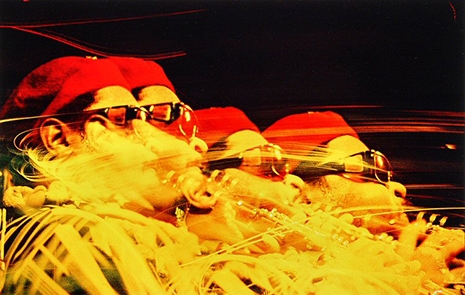
The three short films below are all phenomenal documents of a seminal period in American modern jazz avant-garde experimentation captured candidly, directly, and thrillingly through the superb filmmaking talents of British documentary visionary, Dick Fontaine. Currently head of documentary direction at the National Film and Television School in Great Britain, Fontaine boasts a long career in which he’s created nearly 50 films. Starting out as a researcher for Manchester’s Granada Television, Fontaine is credited with making (in conjunction with the Maysles brothers who later directed Gimme Shelter and Grey Gardens) the first British film that employed direct cinema techniques with 1964’s Yeah! Yeah! Yeah!, a Granada audience hit that captured the Beatles’ first visit to the United States. Music and musicians have been a constant theme in Fontaine’s work, another fine example being 1984’s Beat This! about the golden age of hip-hop in New York City.
Fontaine, himself a musician, clearly understands the power of the on-the-spot creative process. Each of the short films below are vibrant portraits of the artist in the act of making music and include what are perhaps some of the most intimate behind-the-scenes moments ever filmed for some of these frontrunners of the avant-garde all gathered with hand-held cameras and sound equipment. Think jazz versions of Don’t Look Back.
For the sake of chronology, let’s start with 1966’s David, Moffett and Ornette, which captures alto saxophonist Ornette Coleman, bassist David Izenzon and drummer Charles Moffett as they travel to Paris to record the lush soundtrack to an obscure Belgian film called Who’s Crazy?. The performances in Fontaine’s film, which often take place in front of Who’s Crazy? as it is projected for the trio are nothing short of gorgeous, and interviews and candid footage with the band members reveal their reasoning for taking on what was a majorly controversial way of performing at the time. In particular, the interviews with Coleman that address race, sexuality and poverty are so relevant and alive that any serious student of his music simply has to watch this. The soundtrack to Who’s Crazy? on which Coleman plays alto sax, violin and trumpet, was released in 1966.
Who’s Crazy? (1966)
The next film is called Sound?? from 1967. I’d be doing it great disservice by describing it as anything short of importantly badass. The piece, a collaboration between highly influential multi-instrumentalist musical madman, Rahsaan Roland Kirk and avant-garde sound artist John Cage, explores the very nature of sound and music itself as the piece shifts between the two pioneers. Kirk does his thing. He plays onstage with three saxophones at once, and a flute and a whistle. He hands out whistles to the audience at one point and calls for a participatory “blues in the key of W.” He plays with animals at the zoo. The footage of a performance at Ronnie Scott’s in London is incendiary. Cage, for his part, is interspersed throughout the film reading rhetorical questions in a variety of city locations about what it means to make music. If music is just noise, can anyone do it? What’s the point in making it? “Sounds are just vibrations,” Says Cage, “why didn’t I mention that before? Doesn’t that stir the imagination?” The whole thing, if nothing else, certainly stirs the imagination. I really can’t do this justice in a blog post. Just watch it. It’s great.
Sound?? (1967)
The final of the three films, 1968’s Who is Sonny Rollins?, is a more somber affair. It’s a searching portrait of saxophonist Sonny Rollins, who, as the film states, recorded his first record in 1948 and had by 1959 become one of the most important and influential jazz performers in the world. He then summarily quit playing publically. Rollins returned to live performances and recording again in 1962, but by 1968 he was on a second performance sabbatical. He was, to hear Rollins tell it, fed up with the debauchery of the club scene which he simply says “kills off a lot of people.” Rollins and compatriot Paul Jeffrey are filmed improvising on the Williamsburg Bridge, a place where Rollins loved to play, incorporating the sounds of trains and other environmental noise. Rollins and Jeffrey explain their philosophy of freeing music from the club in more candid interviews and Rollins is filmed in a variety of outdoor locations while he explains his musical journey. It’s another fine piece of filmmaking. I’ll be damned if it’s not Charles Moffett (who started out as a trumpet player) who makes another appearance in Who is Sonny Rollins? when Rollins visits a music classroom in Harlem. It would make sense as the two did collaborate on a number of occasions.
Who is Sonny Rollins?
David, Moffett and Ornette and Sound?? were released on DVD as simplyDavid Moffett & Ornette despite the fact that both films are included on the disk.
In 2013, Fontaine released a new film about Sonny Rollins called Sonny Rollins: Beyond the Notes in conjunction with Rollins’ 2010 80th birthday performance at The Beacon Theater in New York.
Previously on Dangerous Minds:
Ornette Coleman: Dancing In Your Head For Decades
‘Beat This!’: Must-see document of Hip Hop’s golden age with Malcolm McClaren, Afrika Bambaataa
Sonny Rollins, Ken Nordine, Was Not Was and Leonard Cohen together on late night TV






